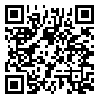Volume 18, Issue 3 (8-2014)
2014, 18(3): 0-0 |
Back to browse issues page
Sekineh Mohammad Alizadeh Charandaei 
 , Fahimeh Sehhatie Shafaei
, Fahimeh Sehhatie Shafaei 
 , Mehrangiz Ebrahimi-Mameghani
, Mehrangiz Ebrahimi-Mameghani 
 , Roghayeh Salmani
, Roghayeh Salmani 


 , Fahimeh Sehhatie Shafaei
, Fahimeh Sehhatie Shafaei 
 , Mehrangiz Ebrahimi-Mameghani
, Mehrangiz Ebrahimi-Mameghani 
 , Roghayeh Salmani
, Roghayeh Salmani 

Abstract: (43 Views)
Introduction: Iron supplements, is the most cost effective and common strategy used in developed countries for the control of iron deficiency. Weekly iron supplementation programs in high schools and middle schools for girls in 2006, has been carried out. This study aimed to determine the status and practice of female students about iron deficiency and iron supplementation and its relation to personal and social factors. Methods: In this cross-sectional study in 2012, 920 pupils from 10 schools were questioned. The questionnaire included demographic information and questions about knowledge and practice. School choice as a quota of five school districts in Tabriz took place. Collected data was analysed by SPSS 13, using inferential statistics methods. Results: The mean (SD) scores of students was 52.4 (13) and practice score was 63.4 (11.3), respectively. 61.6% of the students stated that they "often or always" use tablet distribution. 8% of the sample stated that they had "never" iron distribution in their schools. The most common reason for not taking the tablets was expressed color and taste of the tablets. Conclusion: For better and more effective implementation of iron supplementation programs in schools, iron supplementation and nutrition education classes for students or their mothers and distribution of quality iron tablets are required.
| Rights and permissions | |
 |
This work is licensed under a Creative Commons Attribution-NonCommercial 4.0 International License. |
